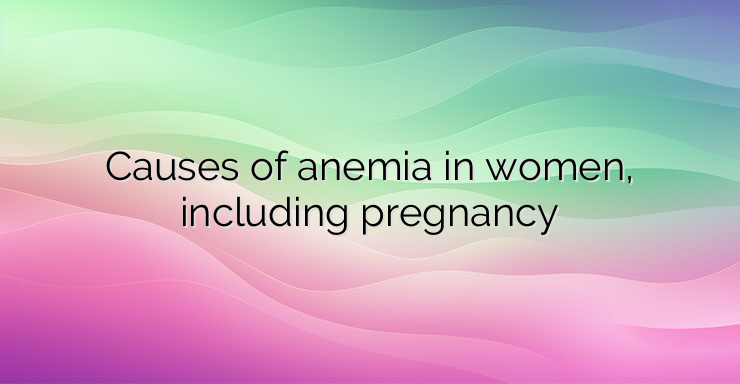The term anemia refers to a hematological disease characterized by a decrease in the number of erythrocytes and/or hemoglobin (Hb) levels per unit volume of blood. Normally, hemoglobin levels in women should vary between 120-160 g/l, and the number of erythrocytes – 4.2 – 5.2 x 10^12. During certain physiological periods of every woman’s life (pregnancy, breastfeeding), increased requirements are observed, necessitating iron supplementation. The reasons for the development of anemia are quite diverse, depending on the size of the erythrocytes, anemia can be normo-, micro- and macrocytic, and depending on the hemoglobin content – normo-, hypo- and hyperchromic. The most common type of anemia among women of reproductive age who have a gynecological problem or are going through a period of pregnancy and breastfeeding is iron deficiency anemia. Iron deficiency anemia is microcytic and microchromic. It occurs due to reduced intake of iron with food, impaired absorption, increased needs (e.g. during pregnancy) or chronic blood loss. Depending on the speed of development, anemias can be divided into acute and chronic. A typical example of acute anemia is acute posthemorrhagic anemia, which is often preceded by hemorrhagic shock and is a life-threatening condition. Acute posthemorrhagic anemia in obstetrics can occur as a result of postpartum uterine hypo- and atony in prolonged delivery of a large fetus, multipartite, excessive use of uterine relaxants, in case of ectopic pregnancy. Acute posthemorrhagic anemia can also occur with rupture of the uterus, as well as with complications during childbirth from the side of the fetus – placenta previa (lowly attached placenta that partially or completely limits the passage of the fetus), placenta accreta (placenta penetrating into a different degree in the depth of the uterine wall), detached placenta, etc. From the side of gynecology, acute hemorrhage can develop in case of rupture of an endometrial cyst, in case of rupture of the ovary. These conditions are accompanied by severe pain, general malaise, fever, nausea, vomiting and require urgent medical intervention. What are the most common causes of chronic iron deficiency anemia in obstetrics and gynecology? 1. Myoma of the uterus – single or multiple benign formations originating from the myometrium of the uterus and occurring mainly among women aged between 30 and 45 years. Often, uterine fibroids are accompanied by heavy and prolonged menstrual bleeding lasting more than 7 days and exceeding 80 ml, which over time lead to iron deficiency. In addition, patients with uterine fibroids suffer from bleeding outside the period of menstruation, which further affects the levels of hemoglobin, red blood cells and iron. 2. Endometrial polyps and polyps of the cervix – frequent benign formations with a weak malignant potential, which can manifest with bleeding between periods, bleeding after intercourse,heavy and profuse menstruation. 3. Malignant formations – carcinoma of the cervix, of the endometrium, of the ovary. They can also manifest with intermenstrual bleeding, bleeding during menopause, which are pathological and result in iron deficiency anemia. Chronic iron deficiency anemia has several periods of manifestation. During the first, so-called latent period, there is a deficiency of iron in the iron depots, without clinical manifestation. In the second, latent period, there is an iron deficiency without a change in the levels of hemoglobin and erythrocytes, while in the third period of iron deficiency anemia there is a change in the clinical indicators (decreased levels of hemoglobin, erythrocytes, hematocrit, serum iron) and a symptomatic manifestation – fainting dizziness, weakness, pale skin and mucous membranes, tinnitus, tachycardia, etc. 4. Iron-deficiency anemia during pregnancy and breastfeeding – the period of pregnancy is associated with an increase in blood volume at the expense of plasma and an increased need for nutrients, trace elements and vitamins. For this reason, the risk of developing iron deficiency anemia during pregnancy is higher and many pregnant women have a mild one. Anemia in pregnant women is defined as a condition in which hemoglobin levels in the second trimester are below 110 g/l, and in the third – below 105 g/l. In pregnant women with iron deficiency anemia, there are risks of premature birth, birth of a child with low weight, increased risk of postpartum hemorrhages, as well as birth of a child with anemia. For this reason, supplementation with iron preparations is recommended at the discretion of the attending physician.In pregnant women with iron deficiency anemia, there are risks of premature birth, birth of a child with low weight, increased risk of postpartum hemorrhages, as well as birth of a child with anemia. For this reason, supplementation with iron preparations is recommended at the discretion of the attending physician.In pregnant women with iron deficiency anemia, there are risks of premature birth, birth of a child with low weight, increased risk of postpartum hemorrhages, as well as of birth of a child with anemia. For this reason, supplementation with iron preparations is recommended at the discretion of the attending physician.


Leave a Reply